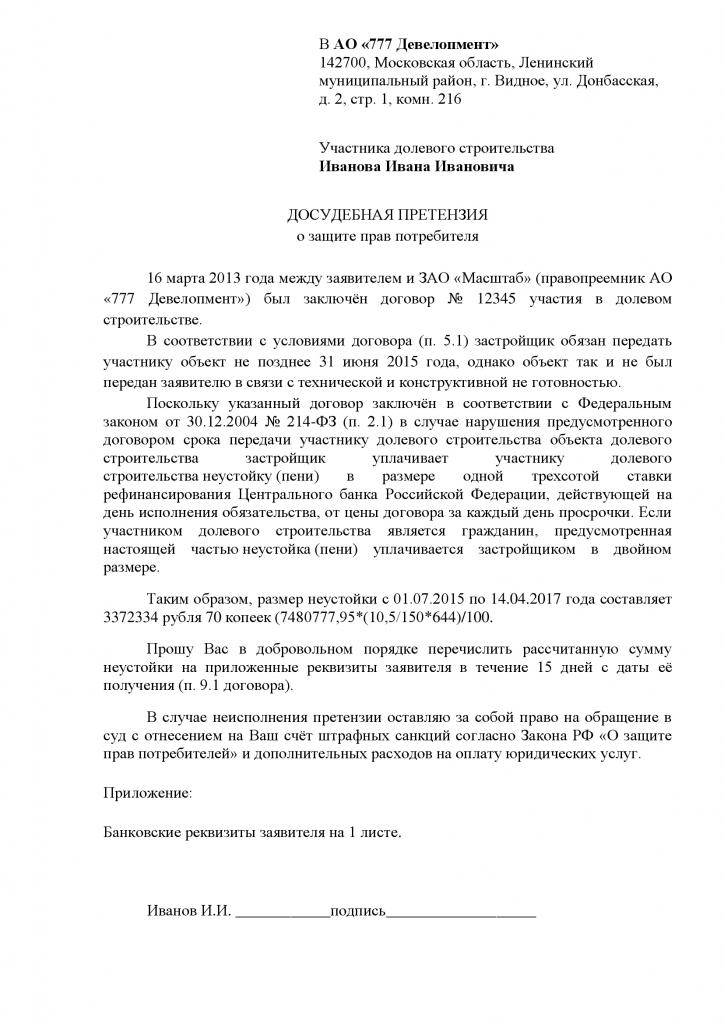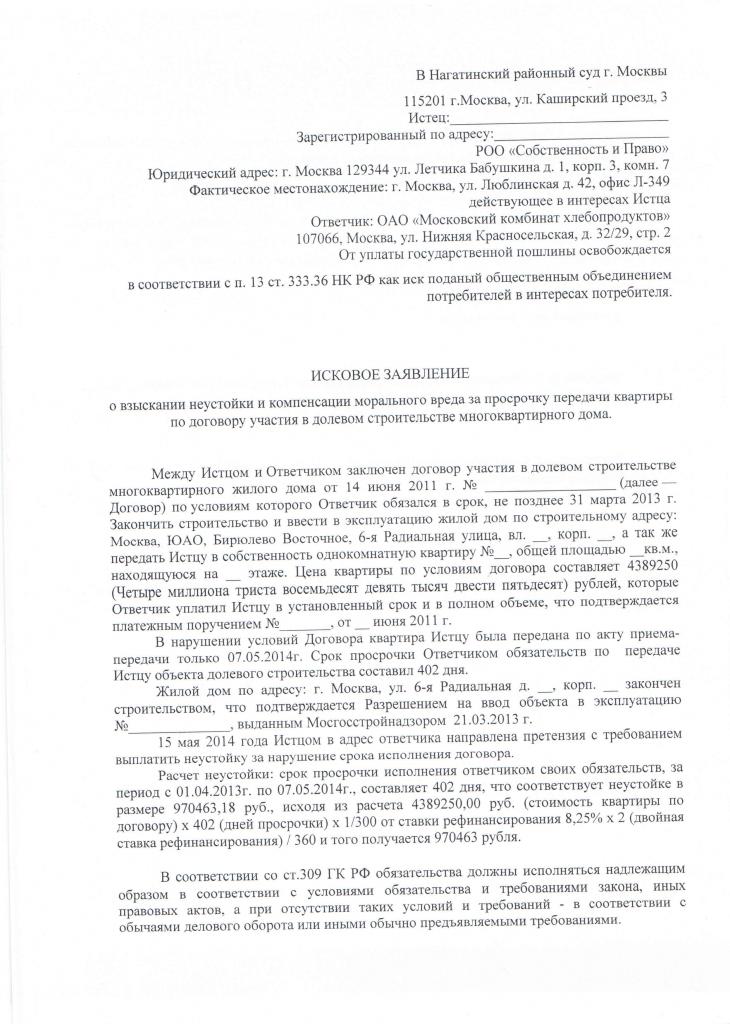Common are situations where citizens prefer to buy apartments in unfinished apartment buildings. In this case, they become participants in shared construction, therefore, with the developer, a DDU is drawn up. This document fully regulates the relationship between investors and the builder.
If any significant clauses of the contract are violated, then each party may bring claims to the other party to the agreement. The most common penalty for damages is due to the DDU due to the fact that the developer was unable for various reasons to put the house into operation on time.
The penalty can be calculated on the basis of information available in the contract, or with the help of data contained in the legislation, if the necessary information is not available in the contract itself.

Legislative regulation
The main law governing the rules for participation in shared construction is Federal Law No. 214. It entered into force in 2015, and its main purpose is to protect depositors from fraud by negligent developers. The features of such a normative act include:
- describes all the nuances of the construction of an apartment building at the expense of investors who are buyers of apartments;
- all relations arising between citizens and the builder are governed exclusively by the provisions of the DDU, which must be drawn up in the correct form and include important conditions for cooperation;
- if the construction company is trying to use another contract, for example, an investment agreement, joint construction or a preliminary document, then investors should remember that the provisions of Federal Law No. 214 do not apply to these documents, so often even lawsuits are not satisfied in case of violations by the developer;
- The DDU is compiled exclusively in writing, and is also registered with the Rosreestr;
- if the construction company violates the terms of delivery of the house or other essential terms of the contract, then a penalty can be collected under the DDU, and the process can be performed by drawing up a complaint to the company or through a court.
Citizens themselves must refuse to sign other types of contracts, since under such conditions they will not be carefully protected from arbitrariness or even fraud by the construction company.

What is included in the agreement?
In the DDU certain conditions and clauses must be indicated, without which it is considered not having legal force. Some developers deliberately exclude some information, due to which they are protected from numerous claims of investors. Therefore, before signing the contract, you should make sure that it is drawn up correctly and that the structure is optimal. By all means in the agreement there should be points:
- an accurate description of the future apartment, which is acquired by the interest holder;
- the plan of the apartment is approved, which includes information about its area, address, number of storeys and other parameters;
- indicate the time during which the finished property must be commissioned;
- the exact value of the property is registered, and ways of how the shareholder can make payments are listed;
- The warranty period for the facility is indicated;
- Methods of fulfilling the obligations specified in the contract by both parties to the agreement are given.
If the above conditions are absent, then the DDU is considered invalid.If the equity holder dies, then all his obligations under the agreement pass to his heirs. Additionally, the rules for the recovery of forfeit under the DDU may be prescribed in the contract. Often the rules for its calculation are often indicated at all, and if no such information is available, then the rules contained in Federal Law No. 214 are applied.
What are the responsibilities of the developer?
The developer is provided by a construction company engaged in the construction of a residential apartment building. When compiling a DDU with interest holders, he has numerous responsibilities, which are listed in this document. If they are violated, then a penalty is collected according to the DDU from the equity holders. The main responsibilities of the developer include:
- the construction of a residential building in a strictly defined time frame;
- putting the facility into operation on time;
- transfer of housing to equity holders on the basis of legal requirements;
- for the construction of housing can be used not only the forces and means of the company, since it can attract subcontractors, but this point should be reflected in the contract;
- the developer bears numerous risks associated with damage to or destruction of an object for various reasons until it is transferred to the ownership of interest holders.
Judicial practice to recover a penalty under the DDD shows that in most cases judges satisfy the requirements of interest holders. Therefore, construction companies have to bear really significant costs associated with covering losses.

Concept of forfeit
The penalty is represented by a certain cash payment, the amount of which depends on the existing violation. Each case is unique, therefore, the procedure for recovering damages according to the DDD is determined by the specific situation.
The collection procedure is governed by the provisions of the Federal Law No. 214, and the necessary information is available in Art. 330 GK. The penalty is represented by the amount of money that must be transferred by the contractor if, for various reasons, he cannot fulfill his obligations under the contract. It is charged if the deadlines for the delivery of the object are violated or serious violations in the apartment are revealed by the interest holders, therefore it does not have the required quality.
Often the penalty is called a fine or fines, although such concepts are incorrect from a legal point of view.
When is it charged?
Judicial practice to recover a penalty under the DDU shows that it can be charged for various reasons. These include:
- the developer cannot put the house into operation within the time period specified in the contract;
- serious interest violations of building codes in apartments are revealed by interest holders;
- the area of the apartment differs from the value indicated in the DDU.
Most often, citizens turn to the court precisely because the deadlines for putting the property into operation are delayed. People cannot use their property for living or other purposes, so they want to reimburse their expenses. Initially, you should try to solve the problems in a peaceful way, but if the company refuses to pay the funds on the basis of the claim, then you will have to draw up a statement of claim for the penalty under the DDU, which will be submitted to the court at the location of the house.

When does the penalty charge begin?
Based on the Federal Law No. 214, each equity holder should know from what date a penalty may be charged. From the correct calculation of the amount depends on how easy it will be to recover from the developer.
Directly in the contract, it is prescribed exactly when the object should be commissioned, since this date is presented in the afternoon when the keys to the apartment must be transferred to the buyer. This period should be the same for all equity holders, which is prescribed in Art. 6 of the law. From this moment, a penalty can be calculated.
The legislation allows for the possibility for the developer to turn to equity holders with a request to conclude an additional agreement to the contract.Such treatment must be in writing only. The supplementary agreement indicates the new deadline for the completion of the facility. Usually a document is signed by real estate investors who want to quickly get their apartment and do not want to spoil relations with the developer.
In the presence of such an agreement, it will not be possible to count on a forfeit. It can be levied only from the moment when the construction company violates the terms specified in the new agreement.

Calculation Rules
The penalty may be charged by pre-trial or judicial method. In any case, the claim or claim is required to indicate the amount of this payment. During its calculation, important points are taken into account:
- the calculation is carried out for each day of delay;
- when calculating, 1/300 of the Central Bank refinancing rate is used;
- the rate is taken on the day when the obligations are not fulfilled;
- for a citizen of the Russian Federation who is a shareholder, the calculated amount is multiplied by 2.
For example, a DDU was compiled with a construction company, on the basis of which an apartment is acquired by a citizen of the Russian Federation. Its cost is 1.4 million rubles. Within the prescribed time period, the apartment was not transferred to the buyer. The refinancing rate is 9%, so the amount of the penalty is calculated:
1 400 000 * 2 * 1/300 * 1 * 9% = 840 rubles. in one day delay.
Calculation is carried out for each day of delay from the moment of its occurrence, and not from the day when the application is transmitted.
Recalculation is still carried out by the developer or the court. If the developer refuses to resolve the issue in a peaceful way, then he will have to file a lawsuit to recover a penalty under the DDU. If in it the amount of claims exceeds 1 million rubles, then under Art. 333.36 Tax Code will have the plaintiff to pay a separate fee.
Voluntary collection of funds
Before going to court, equity holders are required to try to resolve the issue in a peaceful way. To do this, you will have to draw up a claim for the recovery of the penalty under the DDU. A sample claim document is provided below.

The document is transmitted directly to the employee of the construction company. It is necessary to draw up two claims, since one copy remains with the applicant, and also on it the representative of the developer must put a mark on acceptance.
In practice, companies rarely agree to voluntarily pay a penalty, so citizens have to go to court.

Claim Rules
The decision made by the developer regarding the appropriateness of transferring the penalty often depends on the correctness of the formation of this document. Therefore, without fail, information is included in the document:
- name and legal address of the construction company, and this information can be taken from the DDU;
- the address of the house that was not rented out by the builder on time;
- accurate information about the apartment, which should be obtained by the shareholder on the basis of the contract, and this includes its area, number of storeys and other elements;
- a copy of the DDU and documents proving that the citizen paid for the property are attached to the application, and these include various payment documents, for example, a cashier's check or certificate of receipt of funds;
- the requirement is written to pay the citizen a penalty in a specific amount, and in addition, the correct calculation of this amount is given.
If you first study the sample application for the recovery of forfeit under the DDU, then there will be no difficulties with the formation of this document. It is advisable at the end to indicate that if the requirements are not satisfied, the applicant will have to go to court.
You can transfer such a pre-trial claim in different ways:
- personal transfer of the document to the construction company employee under signature;
- sending by registered mail by mail, and in addition it is necessary to save a notification of delivery;
- use of courier services, but in this case, a receipt mark is also needed.
If within a month there is no answer or transfer of funds, then you can safely go to court.
Rules for making a claim
If the funds are not transferred voluntarily by the builder, the interest holders have to recover the penalty under the DDU through the arbitration court. This requires competently writing a statement of claim. A sample of the claim for the recovery of the penalty under the DDU is attached below.

When preparing the document, the nuances are taken into account:
- You can file a lawsuit at the place of residence of the citizen or at the location of the facility under construction;
- if claims are made by several interest holders, then they may unite and file one claim;
- the document indicates all circumstances on the basis of which it is required to charge the penalty, for example, the delay, the terms of the agreement and other data;
- the correct calculation of the penalty is given;
- indicates the need to recover funds from the developer.
If you study the model of the claim for the recovery of the penalty under the DDU, then you do not need to contact the lawyers for its preparation.
What documents are attached to the claim?
The following documents are attached to the lawsuit:
- copy of DDU;
- payment documents confirming the transfer of funds for the apartment;
- a copy of the pre-trial claim, confirming that the interest holder tried to resolve the issue peacefully;
- documentation confirming that the applicant suffered additional losses due to the inability to use his apartment.
Other documents may be attached if necessary. Recovery of a penalty under the DDU without prepayment is not possible, since the calculation takes into account the actual amount of funds transferred to the developer by the interest holder. If only part of the funds was paid, then it is it that is used during settlements.
What to do after a court decision?
Most often, judges award a penalty under the DDU. The court decision contains information on how much should be transferred to equity holders.
If the company refuses to voluntarily pay the funds, then the bailiffs begin to collect them. Often this leads to bankruptcy of companies.

Conclusion
Often, developers who attract interest holders on DDU, can not timely put the house into operation. In this case, buyers may demand a penalty.
You can get this amount of money on the basis of a pre-trial claim or a lawsuit filed in court. It is important to know how to properly compose these documents so that they do not contain any errors or incorrect data.
